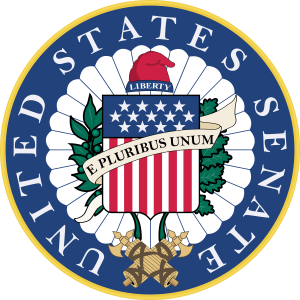By Jim Ellis — Tuesday, Oct. 21, 2025
Senate
 The Federal Election Commission has released new Senate campaign finance numbers and today we begin to preview the resource standing of the key 2026 statewide contests. This Update covers the most competitive campaigns from Alabama through Maine. Tomorrow, we’ll look at Michigan through Texas.
The Federal Election Commission has released new Senate campaign finance numbers and today we begin to preview the resource standing of the key 2026 statewide contests. This Update covers the most competitive campaigns from Alabama through Maine. Tomorrow, we’ll look at Michigan through Texas.
Alabama
Sen. Tommy Tuberville (R) running for Governor has opened the in-cycle Senate contest, and the Republican primary will be the determinative election. Attorney General Steve Marshall, Rep. Barry Moore (R-Enterprise), and retired Navy SEAL Jared Hudson are the major contenders.
Hudson has $357,000 cash-on-hand, while Marshall and Moore each have just over $555,000 in their campaign accounts. It is probable the May 19 primary will end with no candidate having majority support. If such is the case, the top two finishers will advance to a June 16 runoff election.
Florida
Appointed Sen. Ashley Moody (R) must run in 2026 to fill the final two years of the current term. At the end of third quarter 2025, she held $3.6 million cash-on-hand.
The most credible Democrat appears to be technology company executive Hector Mujica. He just announced his candidacy last week; therefore, he is not yet required to file a campaign financial disclosure report. Former Congressman Alan Grayson (D), who has tried and failed several times to win statewide office, holds only $127,000 in his campaign account.
Sen. Moody has won two statewide elections as state Attorney General. In a state turning safely Republican, she is favored to hold her seat.
Georgia
First-term Sen. Jon Ossoff (D) is the 2026 election cycle’s leading fundraiser, having raised more than $54 million. From the gross receipts total, he holds $21.3 million in his account.
The Republicans are headed for a competitive primary, which will likely culminate in a June runoff. Reps. Buddy Carter (R-Pooler/Savannah) and Mike Collins (R-Jackson) along with former University of Tennessee football coach Derek Dooley, son of former University of Georgia legendary coach Vince Dooley, are the top contenders.
Rep. Carter has done best on the fundraising circuit and holds just under $4 million in his campaign account. Rep. Collins has $2.3 million, and Dooley, $1.7 million.
The Republicans’ collective problem is their candidates will have to spend heavily just to win the nomination while Sen. Ossoff can continue to build in unopposed fashion for the general election. Irrespective of who becomes the Republican nominee, the general election promises to evolve into a tight finish.
Illinois
Retiring Sen. Dick Durbin (D) leaves a contested March Democratic primary in his wake, one that will effectively elect the state’s next Senator.
At this point, Rep. Raja Krishnamoorthi (D-Schaumburg) has a commanding lead in fundraising and polling. According to the third quarter FEC report, he has raised just under $25 million and holds a touch over $18 million in the bank.
His two major opponents, Rep. Robin Kelly (D-Matteson/Chicago) and Lt. Gov. Julianna Stratton, are well behind in cash-on-hand. Rep. Kelly reports $2 million in available funds and Stratton just under $1 million. This means that Rep. Krishnamoorthi enjoys a respective 9:1 and 18:1 cash advantage over his two main opponents.
Kentucky
Without Gov. Andy Beshear (D) in the open Senate race, the May Republican primary for all intents and purposes will determine retiring Sen. Mitch McConnell’s successor.
Three candidates are vying for the nomination: Rep. Andy Barr (R-Lexington), former Attorney General and 2023 gubernatorial nominee Daniel Cameron, and businessman Nate Morris. Norris has already been spending heavily and running attack ads, particularly against Rep. Barr.
While Cameron enjoys significant polling leads, it is Rep. Barr who is in the best financial position. He holds $6.7 million in his federal campaign account, while Cameron has just under $630,000. Morris, who is self-financing, reported $1 million at the Sept. 30 disclosure deadline.
Louisiana
Sen. Bill Cassidy (R) may have dodged his toughest general election opponent (former Gov. John Bel Edwards (D) last week announced he would not run for the Senate), but the same can’t be said for the new partisan Republican primary. Louisiana changed its election law, so instead of a jungle primary in November, we will see an April 18 primary followed by a May 30 runoff election if no one reaches the majority support level in the first vote.
At the end of last week, state Rep. Julie Emerson (R-Carencro), who chairs the House Ways and Means Committee, announced her Senate candidacy. This very likely means that Rep. Julia Letlow (R-Start) will not run, as the two were unlikely to oppose each other. Already in the race are State Treasurer, former Deputy White House chief of staff and ex-Congressman John Fleming; state Sen. Blake Miguez (R-New Iberia); and Public Service Commissioner Eric Skrmetta.
Sen. Cassidy is well ahead in fundraising, but President Trump clearly wants to settle a political score with him since the Louisianan was one of seven Republican Senators to vote for impeachment regarding the January 6 US Capitol controversy. Only two of those seven, Sens. Cassidy and Susan Collins, will be on the ballot in 2026. Four are no longer members — Sens. Ben Sasse (NE), Richard Burr (NC), Pat Toomey (PA), and Mitt Romney (UT). Sen. Lisa Murkowski (R-AK) is not in-cycle but is at least a potential gubernatorial candidate.
In terms of fundraising, Sen. Cassidy posts $9.5 million in cash-on-hand. This compares to Sen. Miguez’s $2.5 million and Fleming’s $2.1 million. Rep. Emerson and Skrmetta are not yet required to file disclosure reports.
Maine
Sen. Susan Collins (R) overcame $60 million of spending against her in 2020 and can expect another difficult campaign next year. She is well prepared, with $6.7 million in the bank.
Her principal opponent will be Gov. Janet Mills (D), who just announced her candidacy last week. Like several others in this report, the Governor is not yet required to file a financial disclosure report.
Expect this race to be hot all the way through November and will carry at toss-up rating.





